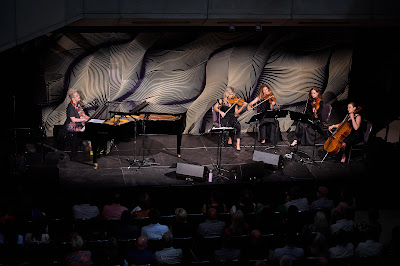Katie Noonan
with the
Sartory String Quartet: Pascal
Whiting and Susannah Williams (violins), Katherine Porter (viola) and Sophie
Curtis (cello)
Art Gallery of Western Australia
February 18, 2022
Katie Noonan has
crafted a remarkable career as a singer, musician, songwriter, artistic
director and musical patron over more than two decades (although it’s fair to
say her musical education began in the womb of her opera singer mother, Maggie).
(pic: Court McAllister)
While she has hardly snuck up on us, her musical interests and accomplishments since she emerged as a lead singer with her band George and their No 1 album Polyserena in 2002 are so wide-ranging as to be an amazement.
Much to the joy of the audience in the grand foyer of the Art Gallery of Western Australia, Noonan took us for an exhilarating ramble across many of the years and styles of that career.
It fell, essentially, into two parts; the first, Noonan at the piano and the Sartory string quartet performed lush, romantic ballads from across her repertoire; the sweet, simple Quiet Day, the gentle torrent of Bluebird, like wind over wings; her setting of Michael Leunig’s sotly-spoken Peace is My Drug, and Lover, My Song for You, her wedding present to her husband, the saxophonist Isaac Hurren (she says he took some time to reciprocate).
This is lovely music, made even more impressive by Noonan’s vocal restraint; there’s not an instant of her using her powers merely to impress – she gives the songs exactly what they need, with very little embellishment, allowing us to slip quietly into their beauty and emotion.
That restraint is also apparent in the arrangements by Dr Steve Newcomb from the Queensland Conservatorium at Griffith University, and is given vivid life by Pascal Whiting and Susannah Williams (violins), Katherine Porter viola) and Sophie Curtis (cello) of Sartory.
After a sad aside concerning the failing health of the great jazz pianist Keith Jarrett (and thanks, Kate, if you could leave the steak knives at the Festival office I’ll pick them up from there), the temperature of the show changed as Noonan left the piano for centre-stage and more complex vocal music featuring the words of two revered Queensland poets, Oodgeroo Noonuccal (Cath Walker) and Judith Wright.
Wright’s Late Spring has been set to music by the illustrious and prolific composer Elena Kats-Chernin, while the settings of Oodgeroo’s The Curlew Cried and Balance were from Queensland composers Thomas Green and Robert Davidson respectively.
The songs, often in minor keys, are musically challenging and unsettling, but Noonan’s taste and vocal tact are constant.
They are also –and this is clearly something of great pride for her – orchestrations she has commissioned, which is an admirable gift to Australian music.
The show ends on a high – Noonan’s own setting of Noonuccal’s anthemic A Song of Hope (“New rights will greet us/ new mateship meet us/ and joy complete us/ In our new dreamtime”) and the high romance of her breakout Breathe in Now.
It gave me an inkling of why she mentioned Keith Jarrett. As she pointed out, he’s famous for his cries of pleasure as he’s playing.
It’s an immersion in the music that has a physical expression she shares with him and other singers – Antony Hegarty and the incomparable Joe Cocker among them – who lose themselves in those same transports of delight.
It was a great joy for us to be taken there with her.


